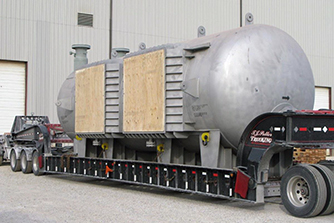For a net-zero future
The B&W Learning Center
Leading the world in clean power production technology
Cylindrical Superheaters for Sulfuric Acid Plant Applications
Benefits of Cylindrical Superheater Casings for Waste Heat Recovery Systems in Sulfuric Acid Plant Applications
Application
- Sulfuric acid plant
- Waste heat recovery system
- High pressure / high mechanical stresses
Rectangular superheater design presents operational challenges
 Sulfuric acid plant waste heat recovery systems operating with rectangular-style superheaters downstream of the converter’s first pass operate in high-temperature, high-pressure service. With gas-side conditions in the range of 1150F (621C) and greater than 7 psig (0.49 barg), high mechanical stresses in the outer casing result in design challenges to accommodate these superheater conditions.
Sulfuric acid plant waste heat recovery systems operating with rectangular-style superheaters downstream of the converter’s first pass operate in high-temperature, high-pressure service. With gas-side conditions in the range of 1150F (621C) and greater than 7 psig (0.49 barg), high mechanical stresses in the outer casing result in design challenges to accommodate these superheater conditions.
To accommodate the rectangular superheater heat transfer coils, the casing of most units are also rectangular with stiffened flat sidewalls and header boxes with square corners. Particularly on large superheaters, the welded corners where two flat casing walls intersect are subjected to high stresses due to internal pressure and thermal expansion. Even stainless-steel casing has relatively low strength at design temperatures near 1200F (649C).
As an alternative to rectangular-style superheaters, in 2007 B&W Chanute developed its Optimus™ cylindrical superheater casing design for installation on a superheater at the largest sulfuric acid plant in North America.
New design provides solution to hot, high-temperature applications
Because of the history and critical nature of the superheater casing, the unit required a cylindrical casing and Finite Element Analysis (FEA) on the final design. Even though the main body and ends of the superheater are cylindrical, conducting an FEA is important because the design of the gas inlet and outlet connections are complex and the most susceptible to failure. At that time, the most popular computer-aided engineering tools for structural design were useful for rectangular casing designs but were not suited for sophisticated FEA of the cylindrical-style casing.
Using advanced, versatile 3D modeling, computer-aided engineering tools and FEA methodology, B&W Chanute developed its Optimus cylindrical superheater casing for waste heat recovery superheaters and economizers.
Several similar projects have been successfully executed in which an old rectangular superheater is replaced with a new cylindrical unit. As sulfuric acid plants continue to get larger, cylindrical superheaters are more often being specified to replace rectangular designs. When properly designed, manufactured and installed, cylindrical superheaters are proving more reliable in these hot, high-pressure applications.
This cylindrical design is now our standard for superheater/economizer casings on sulfuric acid applications across North America, improving overall plant operational reliability.